What is meant by the estimated uncertainty for a measurement
Solution
2)
The quantification of doubt about the measurement is known as the uncertainity.
The true value of measurements always fall with in the range of the measured values.The uncertainity in our measurements is estimated using the best of the result by adding or substracting the measurement of uncertainity. No measurment has exact value. the out come of the result depends on many factors such asmeasuring system or procedure, skill of the measurer, environment and other physical effects.
For example: If a stick is measured using the scale. Let its length be 2.3 cm but the actual lenth of the stick might be 0.1 mm smaller or larger (approx) . This small deviation from the exactt value is known as uncertainity. This 0.1 mm value is added or substracted to the result obtained to find the error in measurement.
The current or voltage can be mesured accurately using the multimeter but still there will be some uncertainity in the measurements. The analog multimeters has there accuracy listed as the full scale reading. When the measeured value is near tto the full scale is known as accurate value.
Anlog meter with accuracy + or - 3% is set to 0-100 V range. Based on accuracy the pointer can be 3V. (100*0.03 V)= 3V below or above the measured reading. If true value is 80 V. The meter is must read 77 V or 83 V or + or - 3 of the measured reading. Howerever, digital multimeters are more accurate than analog.

 Homework Sourse
Homework Sourse